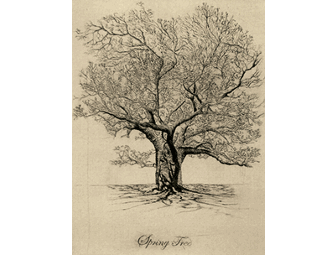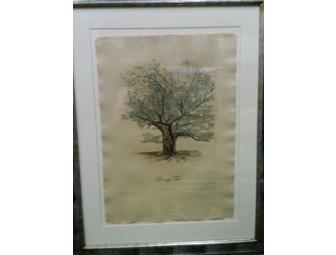Art
Beautiful Framed Print: Spring Time
- Item Number
- 142
- Estimated Value
- 500 USD
- Sold
- 120 USD to selovett
- Number of Bids
- 3 - Bid History
Item Description
From The Elegant Trowbridge Galley:
Spring Time from the Imperial Flowers line:
the frame is silver leaf mirror.
Information on the artists and Printing Process
The printing process
Lyndi Sales hand creates her etchings on copper plates. She uses various etching techniques that include hard ground, soft ground and aquatint etching processes. The plates are prepared and the image is drawn onto the copper plate which is covered in hard ground or soft ground, after which the copper is submerged into an acid bath for the etching to take place. She hand prints the inked etching plates onto the pre-soaked handmade paper
The paper
The paper comes from a very small mill close to where Lyndi Sales lives. It is made from the reeds of the Black River which runs through Cape Town.
Our mountboard
All the board used by Trowbridge is acid free and meet Fine Art Trade Guild requirements for conservation
Each board is lignin free, alkaline sized, pH neutral and is calcium carbonate buffered to enhance its useful lifespan by minimising the effect of atmospheric pollutants
Our frames
For more than 25 years we have been taking pride in our work and the results show in our beautifully crafted fine art.
All of our frames are made by hand by craftsmen using traditional techniques. From workshops in the countryside just outside London our team of expert artisans lovingly put together every Trowbridge framed image, checking quality at every stage of the process.
For our painted frames we use gesso to seal the wood and then apply layers of red or black bolle and paint or silver and gold metal leaf by hand before finishing them by distressing, waxing and applying creta to give them an aged look.
As a result, unlike factory produced products, no two frames will be the same. The variations in finishes add to the charm and individuality of our work.
Our natural wood frames are finished to the highest quality normally reserved for fine furniture.
Item Special Note
Shipping and handling costs are the Responsibility of purchase.
About the Artist:
Lyndi Sales
Anyone who has admired the delicate intricacy of her work, will understand why South African Lyndi Sales is TROWBRIDGE's best-selling artist. She's renowned world-wide for her thought-provoking multi-dimensional works in paper and her installations featuring her homeland's birds and animals.
For her collaboration with TROWBRIDGE, however, Lyndi has drawn inspiration from a long-held fascination with early 17th century botanical engravings, works that she first encountered when studying for her Master's degree at University of Cape Town.
'I found so much beauty in the engravings of those early 17th century botanical artists - pioneers such as Basilius Besler, who nurtured, catalogued and painted new species of plants in such meticulous detail. I really appreciated the way in which the works are able to be both complex and simply descriptive at one and the same time.'
When it came to creating her own engravings in a style that paid homage to those earlier artists, Lyndi felt that the paper she used should be just as key as the images themselves. 'Continuing the natural, antique theme, I decided to use hand-made paper. I'm fortunate in that I am able to source this from a paper mill just a few miles from my studio. It's made from reeds from the Black River - our local water source - and has a wonderful subtle colour and texture.' she says.
The etchings themselves are produced with a sharp etching needle onto copper-plate; the more detailed the image, the longer it will take to produce - the tree images that Lyndi produces for TROWBRIDGE, for instance, are particularly labour-intensive. A number of resists, including wax and a ground substance called rosin, can be applied to mask areas of the plate before it is submerged in an acid bath. The acid bites into the copper and thereby creates different types of tone and finish.
The completed plate is then heated, ink is applied and wiped away so that it's left only in the grooves of the etching. The dampened paper is then applied to the plate and the image is pressed through an old style etching press. Finally, Lyndi hand-colours and signs each image.
'The printing process itself is meditative, almost mesmeric. But what I really love is the actual engraving - searching through ancient images for inspiration, doing my research into the plants I am depicting and choosing the final colours for each work,� she says.
Although Lyndi's are modern pieces, their look and feel is very much that of a period piece. So what does she feel she brings from the 21st century to her decidedly antique looking work? 'Accessibility,' she says. 'Not only are 17th century originals today priceless, when they first appeared they were ground-breaking, only produced in very small numbers and extremely costly. I, on the other hand, am able to produce and distribute my work far more quickly and easily. And, of course, because the works depict the natural world, they're timeless - which is why I guess they fit so well into a variety of different settings and homes.'
Lyndi Sales
Anyone who has admired the delicate intricacy of her work, will understand why South African Lyndi Sales is TROWBRIDGE's best-selling artist. She's renowned world-wide for her thought-provoking multi-dimensional works in paper and her installations featuring her homeland's birds and animals.
For her collaboration with TROWBRIDGE, however, Lyndi has drawn inspiration from a long-held fascination with early 17th century botanical engravings, works that she first encountered when studying for her Master's degree at University of Cape Town.
'I found so much beauty in the engravings of those early 17th century botanical artists - pioneers such as Basilius Besler, who nurtured, catalogued and painted new species of plants in such meticulous detail. I really appreciated the way in which the works are able to be both complex and simply descriptive at one and the same time.'
When it came to creating her own engravings in a style that paid homage to those earlier artists, Lyndi felt that the paper she used should be just as key as the images themselves. 'Continuing the natural, antique theme, I decided to use hand-made paper. I'm fortunate in that I am able to source this from a paper mill just a few miles from my studio. It's made from reeds from the Black River - our local water source - and has a wonderful subtle colour and texture.' she says.
The etchings themselves are produced with a sharp etching needle onto copper-plate; the more detailed the image, the longer it will take to produce - the tree images that Lyndi produces for TROWBRIDGE, for instance, are particularly labour-intensive. A number of resists, including wax and a ground substance called rosin, can be applied to mask areas of the plate before it is submerged in an acid bath. The acid bites into the copper and thereby creates different types of tone and finish.
The completed plate is then heated, ink is applied and wiped away so that it's left only in the grooves of the etching. The dampened paper is then applied to the plate and the image is pressed through an old style etching press. Finally, Lyndi hand-colours and signs each image.
'The printing process itself is meditative, almost mesmeric. But what I really love is the actual engraving - searching through ancient images for inspiration, doing my research into the plants I am depicting and choosing the final colours for each work, she says.
Although Lyndi's are modern pieces, their look and feel is very much that of a period piece. So what does she feel she brings from the 21st century to her decidedly antique looking work? 'Accessibility,' she says. 'Not only are 17th century originals today priceless, when they first appeared they were ground-breaking, only produced in very small numbers and extremely costly. I, on the other hand, am able to produce and distribute my work far more quickly and easily. And, of course, because the works depict the natural world, they're timeless - which is why I guess they fit so well into a variety of different settings and homes.'
West Side YMCA stores data...
Your support matters, so West Side YMCA would like to use your information to keep in touch about things that may matter to you. If you choose to hear from West Side YMCA, we may contact you in the future about our ongoing efforts.
Your privacy is important to us, so West Side YMCA will keep your personal data secure and West Side YMCA will not use it for marketing communications which you have not agreed to receive. At any time, you may withdraw consent by emailing Privacy@frontstream.com or by contacting our Privacy Officer. Please see our Privacy Policy found here PrivacyPolicy.


